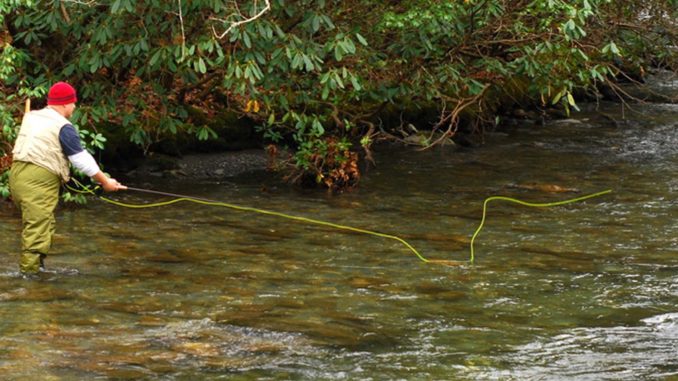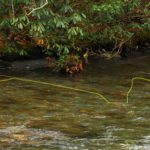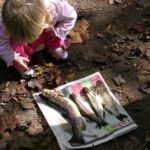
Quill Gordons, Blue-winged Olives stir up trout
Beginning around the middle of March, streams begin warming up, trout become active and hungry, and mountain anglers enjoy some of the best trout fishing of the year.
In the spring, when hatches occur frequently and in great variety, trout become veritable eating machines. Also, streams are full and gushing due to the wet winter, which means more oxygen in the water, another factor that makes fish more active.
What all this means is that even a trout fisher with marginal skills has a good chance of catching fish.
One of the earliest and best spring flies is the Quill Gordon, a Mayfly pattern originated by Theodore Gordon, considered the father of American fly fishing. Depending on water temperatures, Quill Gordons emerge in mid-February and continue through March. It and the ubiquitous Blue-Winged Olive are about all you need for a successful day on the water. Go with larger patterns such as Nos. 18 or 16 to attract larger trout, big browns included. The best times to fish the Quill Gordon is mid-morning to mid-afternoon when water temperatures are in the 50s.
If you are unable to find a Quill Gordon, a regular male Adams or parachute Adams provides a good imitation.
If the water is too cold for a Quill Gordon hatch, stick with midges or stone flies and caddis flies such as Dark Stone, Black Caddis and Brown Caddis. Also, nymph forms of hatches can be effective for sub-surface fishing. You can get the best of both worlds by using a dry-fly as a strike indicator and a smaller nymph pattern as a dropper.
In late March, other Mayfly hatches emerge, particularly the Blue Dun, Hendrickson, Red Quill and March Brown in sizes 16-14.
During April and May, at least 20 different hatches occur. Each hatch has dry flies, nymphs, and emergers.
If keeping up with so many hatches is a bother, you can narrow your options to three flies: two nymphs and one dry fly.
In nymph patterns, a Gold Ribbed Hare’s Ear and a Pheasant Tail will serve you well. A beadhead will add extra weight to get the fly down to where nymphs usually are found.
For a universal dry-fly, a regular Adams or parachute Adams will work in all types of water.
Fly fishing, of course, is not the only method of catching trout. While a few streams are limited to fly fishing, the majority of mountain streams may be fished with flies or artificial lures. Live bait is limited to streams that are stocked with hatchery-raised trout and posted as hatchery-supported waters. Live bait also may be used in streams designated as wild trout/natural bait waters.
Regulations for wild trout waters in the national forests and Great Smoky Mountains National Park stipulate that artificial lures, such as spinners, must have a single hook. A legal spinner can be made from a treble-hook spinner by clipping off the extra hooks. However, the spinners do not spin as well as those that are manufactured with single hooks.
Bright colors are best for springtime fishing, especially yellow and chartreuse. Lure size depends on the type of water. Early in the spring when streams are full, a one-eighth ounce lure is very effective; later on, when the water levels drop, or if you’re fishing small streams, switch to one-sixteenth ounce lure. Six-pound test line is recommended for larger lures and 4-pound test for smaller lures.
Many spinner fishers say a spinner’s blade color should be keyed to the type of water being fished. If the water is clear, use a gold blade; if the water is slightly colored, use a silver blade.
Although rules are strict for wild trout waters, just about anything goes in hatchery-supported streams. Nightcrawlers, earthworms, meal worms, wax worms, crickets, and other live baits are legal. Lures can be either single or treble hook. With rare exceptions, these streams do not have size limits. Fishers should note that hatchery-supported waters are closed during March. The season reopens at 6 a.m. Saturday, April 7.
Nightcrawlers and earthworms have been traditional baits in the mountains for decades, but some artificial baits, especially Power Bait, catch as many fish as live bait. Dyed salmon eggs also do well, especially when fishing for big browns.
In normal water conditions, chartreuse and yellow Power Baits get excellent results. If the water is dingy, use fluorescent orange, red, or pink.
Keep a variety of spinners such as Rooster Tails, Panther Martins, Mepps, Blue Fox, Joe Flies in a variety of sizes and colors. If one pattern doesn’t work, keep switching until you find one that does work.
Early spring is an ideal time to get out on a stream. The fish are hungry and active, and only a few die-hard fishers will be on the stream.






Be the first to comment